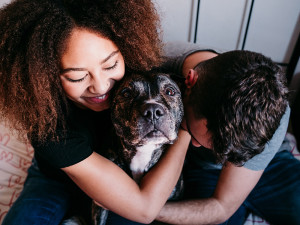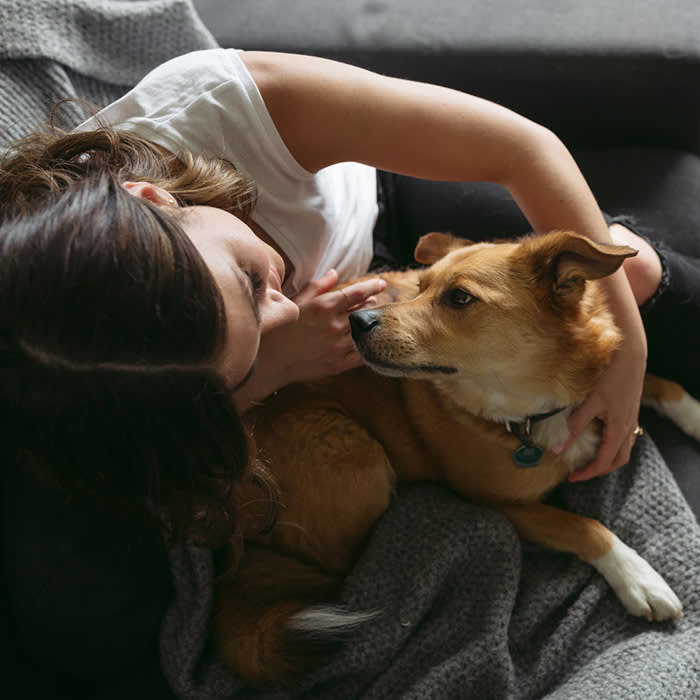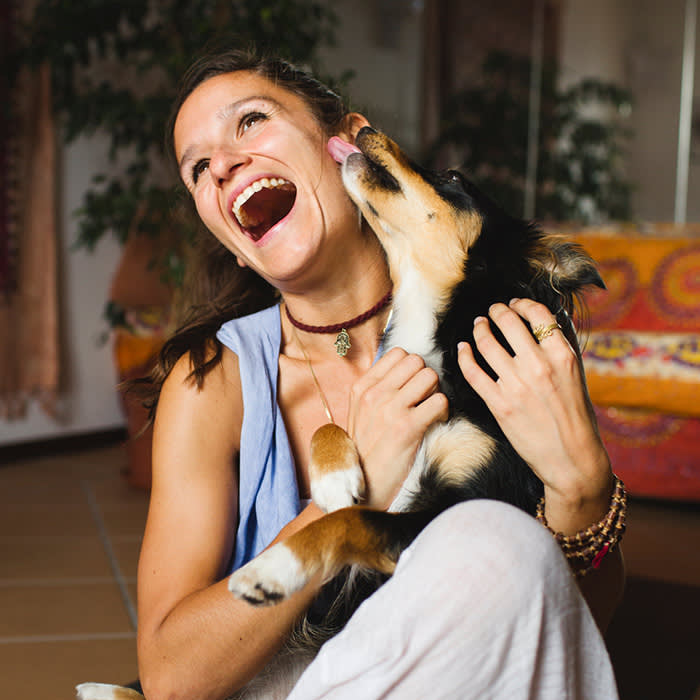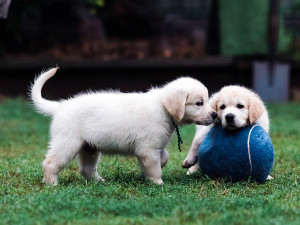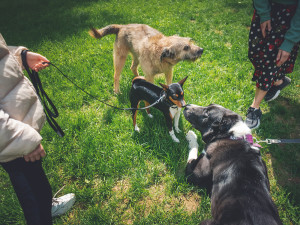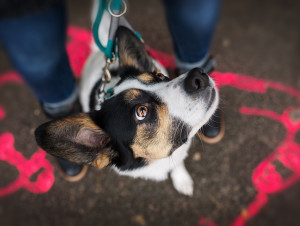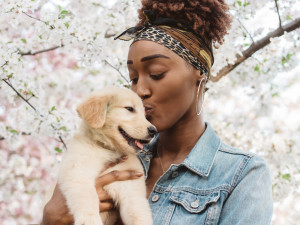How to Know If Your Dog Has Imprinted on You
This has nothing to do with a werewolf named Jacob in a series called Twilight, but here’s what it is all about.
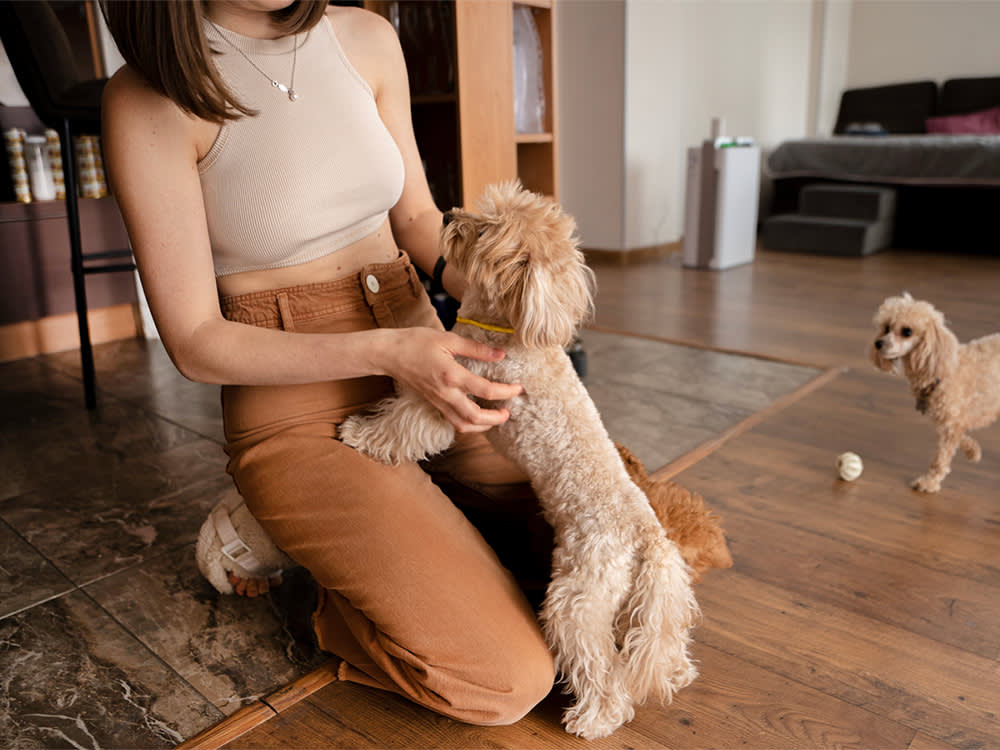
share article
Does your dog only have eyes for you? Do they look to you for guidance more than they do other members of the family? According to the Internet, those might be signs your dog imprinted on you. But we wanted to find out for sure. So, we checked in with Dr. Valli Parthasarathy, a board-certified veterinary behaviorist and co-founder of Synergy Veterinary Behavioropens in a new tab, to understand what imprinting actually is.
What does dog imprinting mean?
Imprinting in dogs is a specialized form of rapid learning that occurs during specific developmental periods. Signs of a dog imprinting on you include: closely following you, mimicking your behavior, readily obeying your commands, seeking your companionship, making eye contact, and showing affection. Imprinting can lead to a strong attachment, which may have both positive and potentially distressing aspects for the dog.
What are the signs your dog has imprinted on you?
What does it mean when a dog imprints?
“Imprinting is a special type of learning that is rapidly occurring and age-dependent,” Dr. Valli, who prefers to go by her first name, tells The Wildest. “Imprint periods are often very discretely defined periods of development, and if that period is missed, then that learning will not take place.”
Imprinting is most closely associated with precocial species. These are birds, cattle, sheep, or other species that are hatched or born with their sight, hearing, and other senses fully formed. Take a baby chick, for example. They enter the world able to immediately move around their environment, which means they need to figure out who their parents are very quickly, so they know who to model their behavior after. As a result, a chick will imprint on the first moving thing it sees and will follow it around exclusively. Ideally, that moving thing is its mother. But it could be, say, a lawnmower. Given the magnitude of this first attachment, appropriate imprinting is critical for these species.
Can dogs imprint on humans?
Dogs are an example of an altricial species (as are cats and humans). Their senses are not fully developed at birth, and they can’t move about their environment right away, so their impressionable periods work a little differently. Dr. Valli explains:
“Dogs don’t imprint in the same way that precocial species do. However, they do have sensitive periods in which their brains are primed to learn about the individuals around them. Typically this occurs between three to 12 weeks of age. During the early part of this period, they form their intra-dog relationships and learn about their immediate environment. They also learn dog-to-dog social skills such as bite inhibitionopens in a new tab and canine social signalingopens in a new tab. Then, from weeks seven to 12, they are primed to learn about the larger world, including people and how to interact with them.”
It’s the latter part of this phase when you are most likely to make an everlasting impression on your pup. It may also be when your dog starts to view one person as their primary caretaker and all-around BFF. So in a more general (but less scientific) sense, this is when a dog can “imprint” on a person and start to pick up cues from them.
But what if you get your dog later in life when they’re past this initial rapid learning phase? “With dogs, there’s some flexibility around when learning occurs and when social bonds can be made,” Dr. Valli says. “Dogs can still be introduced to new things and people after the initial socialization periodopens in a new tab. However, it may be a bit more difficult or take more time, so patience is key.”
Can dogs imprint on more than one person?
Dogs typically imprint on one person, meaning they bond to one human in particular as their source of food, shelter, and safety. Though dogs can bond closely to other people in the household, they tend to follow around and listen to the person they imprinted on.
Can your dog be too attached to you?
It feels good to be your pup’s numero uno. But is there a potential downside to this attachment thing? Dr. Valli says it can vary by dog.
“If a dog has a strong attachment to you, that can be beneficial or problematic depending on the individual dog,” she says. “For example, a dog with a strong interest in an individual may be more willing to come to that person when asked, engage with them in training, and spend more time with them. However, in some dogs, a strong attachment could be associated with distress when that person is not present.”
How long does it take for a dog to imprint on a human?
As Dr. Valli says, the socialization period can vary between dogs. They will likely imprint between the ages of three to 12 months, as previously mentioned, but every dog is different, so remember to be patient with your pup.
What are the three stages of puppy imprinting?
1. Canine imprinting
This stage first begins when the dog is between two to three weeks old and lasts until they are seven months. This period is when a puppy is learning and observing other dogs, especially their mother, so that’s why it’s important for puppies to stay with their mothers at least until they are eight weeks old.
2. Human imprinting
This stage usually happens when puppies are between seven and 12 weeks old. It means they’ve chosen one human in their family with whom to bond. Sometimes, they will also choose another animal in the house, too. At this stage, they are learning how to interact with living beings that are different from them.
3. Fear imprinting
This is when puppies are most likely to develop intense fears of even seemingly minor factors. Make sure you keep trainingopens in a new tab and the rest of their environment positive because this is when your pup could become scared or anxious, caused by specific triggers. Fear periods usually happen between eight to 11 weeks and six to 14 months.
Explaining common dog imprinting behaviors
If your dog has imprinted on you, you will notice that they will act quite attached to you. You might not be able to go far without them following you around (hello, bathroom trip for two?), and they might experience separation anxietyopens in a new tab or similar anxious behaviors when you are not with them.
If you have concerns about separation anxiety or other signs that your dog struggles when you’re not around to show them the ropes, check in with your regular veterinarian or a veterinary behaviorist for advice on managing their behavior.
Why does my dog follow me everywhere?
If you have a little shadow, this likely means your dog trusts and loves you deeply. You make them feel safe and cared for. It might be annoying that they are trailing you just about everywhere you go, but you’re their person, and that has to feel good.
Why does my dog mirror me?
A study published in 2017 by researchers in Austria fopens in a new tabound that dogs are sensitive to their parents’ emotional states and can pick up those feelings over time and begin to mirror their humans’ behavior.
Why does my dog listen to me but not others?
If you are the only one who is practicing training with your dog, you will likely be the only person your dog listens to. This is why it’s important for all family members — if you do not live alone — to participate in training, so there is consistency in your dog’s behavior. Otherwise your dog will learn to only respect your commands and not others.
Why is my dog always “checking in” with me?
If your dog is constantly checking in with you, they are probably emotionally attached to you. They feel safe and secure when they are near you and know where you are.
Why does my dog always want to be near me?
Likewise, your dog wants to be near you because you provide comfort and safety to them. It could also be that they are trying to communicate something with you — they may be hungry or want to go for a walk.
Why does my dog look me in the eye?
Your dog stares soulfully into your eyes because they love you! In fact, staring into each others eyes releases oxytocin aka the love hormone — for both humans and dogs.
Why does my dog enjoy laying in my laundry?
The number one reason is because your laundry smells like you! Again, it’s comforting and feels safe for them to be surrounded by your scent.
How does my dog know when I’m upset?
Dogs are pretty amazing creatures — they can use all of their senses to tell how we’re feeling: Research shows they can recognize humans’ emotions in our facial expressions. Dogs can also smell whether people are fearful or happy.
Why does my dog know when I need attention?
Because your dog can sense your emotions, they can probably pick up on your cues when you are craving their attention.
Why is my dog always in my stuff?
Your stuff smells like you! And as we’ve established, your dog loves the way you and your stuff smells (including your laundry.) It’s another sign that they want to be close to you.
Why does my dog lick me?
Dogs lick their humans for many different reasons. This is a way of grooming you and expressing their love, but it’s also how they might get your attention or soothe themselves if they are feeling stressed. Or maybe you just worked out, and your salty, sweaty skin tastes good to them (probably not the post-workout routine you were looking for, but hey). Your dog might also lick you to get you to stop doing something they are not enjoying. It’s always important to pay attention to their other body languageopens in a new tab.
Why does my dog sleep by my feet?
Remember that bit about how dogs feel more safe with a certain person in their family? If your pup is snoozing at your feet, this means they feel secure with you. You mean safety and comfort to them.
Why does my dog get excited when I come home?
Your dog is excited by your presence, and you make them happy. So, when you come home after being gone (even if you were just running to the grocery store for five minutes), they are overwhelmed by the fact that you’re back with them.
FAQs (People also ask):
1) What does it mean when a dog imprints?
When a dog imprints on you, this means they consider you to be a safe person who makes them feel secure. They might decide this about you within the first 12 weeks of their life, depending on when you brought them home.
2) How do you know if a dog imprinted on you?
When a dog imprints on you, you might notice that they follow you around the house, mirror your behaviors, consider themself to be your caretaker, and nestle among your things. When you come home after being gone, they are super excited to see you. There are other signs (see above), but you’ll be able to tell pretty quickly if they consider you to be their special person.
3) How long does it take for a dog to imprint on a human?
It can take up to 12 weeks for your puppy to imprint on you. Usually, the human imprinting stage starts at seven weeks. Before that, they are in the canine imprinting stage, when they are observing behaviors of other dogs, especially their mother.
4) At what age do dogs stop imprinting?
Dogs stop imprinting around four months old, after they’ve completed the three stages of imprinting: canine, human, and fear.
5) How do dogs choose their favorite person?
A puppy who’s imprinting might choose their favorite person because that person is the one providing them the most care during their early development. That person offers them security and is someone they trust.
6) Can dogs change their favorite person?
Depending on life circumstances and how much time a person spends with a dog, a pup’s bond with them can strengthen. So, for example, if your partner was always your dog’s go-to person because they worked from home and cared for the dog more, but you work from home now, too, this extra time with your dog can help strengthen your relationship.
7) Do dogs bond when they sleep with you?
Although many trainers (and allergistsopens in a new tab) might not recommend that you let your dog sleep in your bed, experts now suggest that sleeping with your dog can increase your bond with your pup.
“I love that we’re reversing the question,” Dr. Dana Varble, the chief veterinary officer for the North American Veterinary Community told CNN in 2021opens in a new tab. “In general, it is a very good thing for animals to sleep with their people.” She added: “Dogs and cats who are more closely bonded with their humans get additional health benefits, including increases in beneficial neurotransmitters such as oxytocin and dopamine, the feel-good hormones.”
8) What is a velcro dog?
The term “velcro dog” is used to describe a dog who stays close to you or may also be described as “clingy.” The latter has negative connotations; a dog who sticks to you like velcro is really just comforted by your presence.
Resources

Kate Sheofsky
Kate Sheofsky hails from San Francisco, where she developed a love of writing, Giants baseball, and houses she can’t afford. She currently lives in Portland, OR, and works as a freelance writer and content strategist. When not typing away on her laptop, she enjoys tooling around the city with her two rescue pups searching for tasty food and sunny patios.
Related articles
![Two Golden Retriever puppies playing with a large blue tennis ball outside in the grass]() opens in a new tab
opens in a new tabWhat to Expect at Puppy Socialization Classes
A dog behaviorist schools us on why puppy classes are more about socializing than getting straight As.
![Three dogs on leashes meeting and sniffing each other on a walk on the summer grass with owners]()
How Do I Get My Shy Dog To Socialize?
The Wildest Collective dog trainer Robert Haussmann’s tips for getting a shy pup to go from wallflower to social butterfly.
![Couple hugs their merle Boxer]() opens in a new tab
opens in a new tabHow to Improve Your Relationship with Your Dog
Animal behaviorist Dr. Karen B. London on how to strengthen your pet-parent bond.
![Dog on leash sitting on a colorful street and looking attentive at their pet parent]() opens in a new tab
opens in a new tabHow to Get Your Dog to Pay Attention to You
Here are some simple steps to pry your pup away from that one spot in the yard they’re obsessed with.
![woman draped in an orange blanket holds a black-and-white puppy]() opens in a new tab
opens in a new tab5 Development Stages You Should Know When You Get a Puppy
It’s like What to Expect When You’re Expecting, except add “four little paws to run around your house” to the title.
